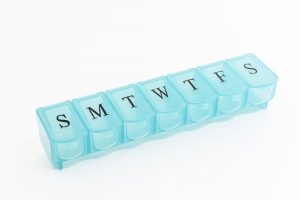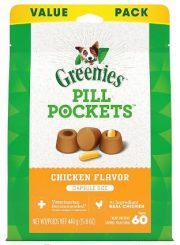By Gwen Rockwood, newspaper columnist and mama of 3
When I get up in the morning, the first thing I do – before caffeine and hygiene – is trick the dog and cat. Sometimes it works. Sometimes it doesn’t. But the attempt has become my morning ritual – an act of love and deception.
Each night, I arrange the dog and cat’s food bowls and other tools of trickery on the kitchen counter so everything is ready for the morning. If your brain (like mine) wakes up later than your body, it’s helpful to dummy-proof the process so you can fall back on routine and muscle memory.
 Tom and I have reached that magical age where even our pets have their own pill organizers. I labeled them with the pets’ names because I’m worried I’ll mix them up or take them myself during the morning brain haze.
Tom and I have reached that magical age where even our pets have their own pill organizers. I labeled them with the pets’ names because I’m worried I’ll mix them up or take them myself during the morning brain haze.
Our formerly fat cat needs medicine because her thyroid gland shifted into overdrive last year and made her rail thin. The dog needs an antihistamine because his allergies flare up when the temperature gets above freezing, which only happens 98 percent of the year.
These pets need but don’t want medicine. They basically gave our veterinarian the furry middle finger when she prescribed pills. They hissed and snarled, still outraged by the doctor’s back-door temperature-taking method.
I knew the daily pill routine would be challenging. Some pets will eat anything that has a dab of food on it. (I’m convinced our 80-pound Goldendoodle would eat a rusty carburetor if we smeared some Jif peanut butter on it.) But other animals have a weird sixth sense when even a tiny pill is slipped into their breakfast.
During the first few days of morning medication, I inspected the cat’s food bowl and realized she’d eaten everything except the small pill I’d buried under her food. And the peanut butter trick only worked twice on our suspicious Corgi before the jig was up, and he refused it.
When I was a kid, and one of our cats got sick, my mom would stick a pill down the cat’s throat the way she’d seen the vet do it. Then she’d hold the cat’s mouth closed and rub the neck to encourage swallowing. But all the squirming and yowling (by the cat, not my mom) made me so nervous that I’d gag on the cat’s behalf. The whole thing looked traumatic.
I knew the brute force tactic wouldn’t work for me, so I experimented with ways to con the cat and dupe the dog. My current strategy has been working for a while, so maybe I’m on to something. Based on my unscientific research, the following elements are helpful when deceiving dogs and fooling felines:
Camouflage: The pill needs a disguise. Peanut butter or cheese works for many pets, but I use chicken-flavored Pill Pockets, which are like edible chunks of Play-Doh that can fully cover terrible tablets.
 Gravy: Perhaps it’s my Southern roots talking, but gravy is good for anything. Put a glob of gravy, broth, or pureed food over a Pill Pocket to help mask the smell of medication. (According to the American Kennel Club, dogs’ noses are 100,000 times more sensitive than the human nose. So, yes, that pill really does have a smell, and your dog definitely knows it.)
Gravy: Perhaps it’s my Southern roots talking, but gravy is good for anything. Put a glob of gravy, broth, or pureed food over a Pill Pocket to help mask the smell of medication. (According to the American Kennel Club, dogs’ noses are 100,000 times more sensitive than the human nose. So, yes, that pill really does have a smell, and your dog definitely knows it.)
Texture: If a glob of peanut butter or a Pill Pocket always has a hard, bitter tablet inside, the furry patient will avoid them altogether. So, I started putting a few small, empty Pill Pockets in the same bowl as the one containing the pill. It’s like a shell game. Once my cat gets a pill-free morsel, she’s more likely to take a chance on the next treat that looks and smells similar. I also mix a few crunchy treats with the soft ones to keep them guessing.
But as we all know, pets are crazy-smart. What works on Monday might fail by Friday. Sometimes, we’ll have to change the game to keep it going. If you have tried-and-true methods for medicating your fur babies, send them my way.
And may all our four-legged buddies be none the wiser about the daily dose of love we smuggle into their food.
Gwen Rockwood is a syndicated freelance columnist. Email her at gwenrockwood5@gmail.com. Her book is available on Amazon.
